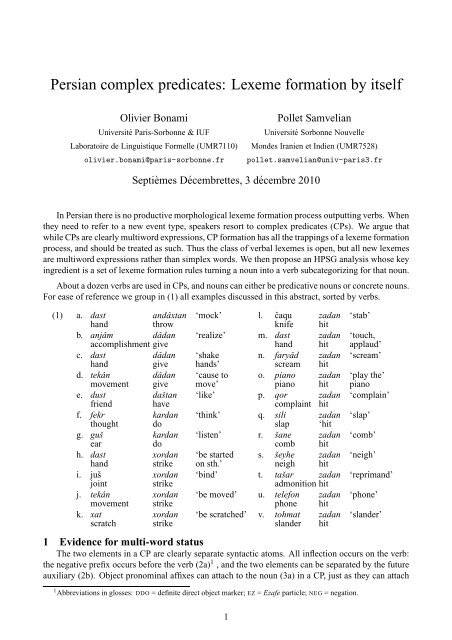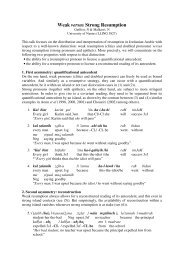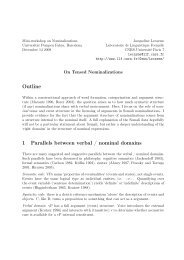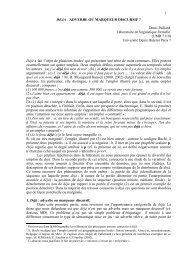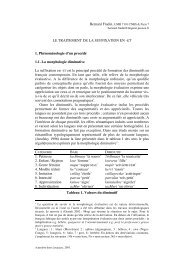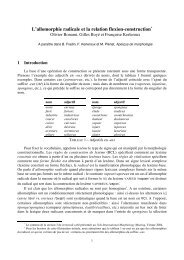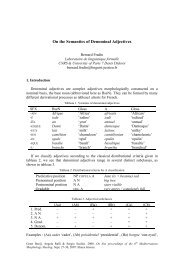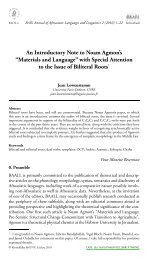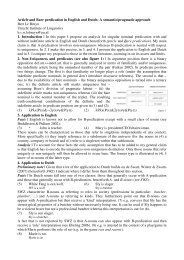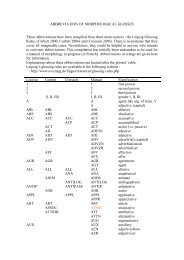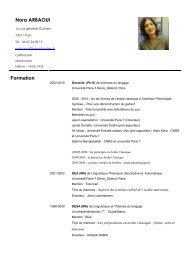Persian complex predicates: Lexeme formation by itself
Persian complex predicates: Lexeme formation by itself
Persian complex predicates: Lexeme formation by itself
Create successful ePaper yourself
Turn your PDF publications into a flip-book with our unique Google optimized e-Paper software.
<strong>Persian</strong> <strong>complex</strong> <strong>predicates</strong>: <strong>Lexeme</strong> <strong>formation</strong> <strong>by</strong> <strong>itself</strong>Olivier BonamiUniversité Paris-Sorbonne & IUFLaboratoire de Linguistique Formelle (UMR7110)olivier.bonami@paris-sorbonne.frPollet SamvelianUniversité Sorbonne NouvelleMondes Iranien et Indien (UMR7528)pollet.samvelian@univ-paris3.frSeptièmes Décembrettes, 3 décembre 2010In <strong>Persian</strong> there is no productive morphological lexeme <strong>formation</strong> process outputting verbs. Whenthey need to refer to a new event type, speakers resort to <strong>complex</strong> <strong>predicates</strong> (CPs). We argue thatwhile CPs are clearly multiword expressions, CP <strong>formation</strong> has all the trappings of a lexeme <strong>formation</strong>process, and should be treated as such. Thus the class of verbal lexemes is open, but all new lexemesare multiword expressions rather than simplex words. We then propose an HPSG analysis whose keyingredient is a set of lexeme <strong>formation</strong> rules turning a noun into a verb subcategorizing for that noun.About a dozen verbs are used in CPs, and nouns can either be predicative nouns or concrete nouns.For ease of reference we group in (1) all examples discussed in this abstract, sorted <strong>by</strong> verbs.(1) a. dasthandandˆaxtanthrow‘mock’b. anjˆam dˆadanaccomplishment give‘realize’c. dasthanddˆadangive‘shakehands’d. tekˆanmovementdˆadangive‘cause tomove’e. dustfrienddaštanhave‘like’f. fekrthoughtkardando‘think’g. gušearkardando‘listen’h. dasthandxordanstrike‘be startedon sth.’i. jušjointxordanstrike‘bind’j. tekˆanmovementxordanstrike‘be moved’k. xatscratchxordanstrike‘be scratched’l. čaquknifezadanhit‘stab’m. dasthandzadanhit‘touch,applaud’n. faryˆadscreamzadanhit‘scream’o. pianopianozadanhit‘play the’pianop. qorcomplaintzadanhit‘complain’q. silislapzadan‘hit‘slap’r. šanecombzadanhit‘comb’s. šeyheneighzadanhit‘neigh’t. tašar zadanadmonition hit‘reprimand’u. telefonphonezadanhit‘phone’v. tohmatslanderzadanhit‘slander’1 Evidence for multi-word statusThe two elements in a CP are clearly separate syntactic atoms. All inflection occurs on the verb:the negative prefix occurs before the verb (2a) 1 , and the two elements can be separated <strong>by</strong> the futureauxiliary (2b). Object pronominal affixes can attach to the noun (3a) in a CP, just as they can attach1 Abbreviations in glosses: DDO = definite direct object marker; EZ = Ezafe particle; NEG = negation.1
Karimi-Doostan, G. (1997). Light verb constructions in <strong>Persian</strong> and Kurdish. Ph.D. thesis, Universityof Essex.Koenig, J.-P. (1999). Lexical relations. Stanford: CSLI Publications.Müller, S. (in press). ‘<strong>Persian</strong> <strong>complex</strong> <strong>predicates</strong> and the limits of inheritance-based analyses’.Journal of Linguistics, 46.Riehemann, S. (1998). ‘Type-based derivational morphology’. Journal of Comparative GermanicLinguistics, 2:49–77.Sag, I. A. (2007). ‘Sign-based construction grammar: An informal synopsis’. Ms., Stanford University.Spencer, A. (2004). ‘Generalized paradigm function morphology’. Ms., University of Essex.


